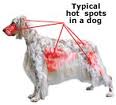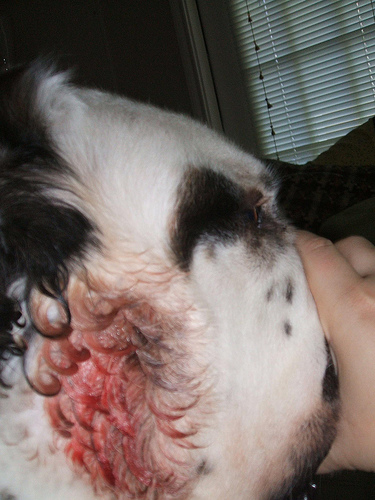You know when you were little and you fell off your bike and got a “strawberry” on your leg? That painful, swollen, red sore that oozed puss and your mom told you not to scratch it or touch it, so it wouldn’t get bigger? I never listened and of course they always grew larger and I have a couple scars to prove it. Our dogs can get these too and because they have fur, they can get infected quickly.
Hot Spots? What are They?
 This type of sore on a dog is called acute moist dermatitis. Simplified, a small, wet, irritating spot on the skin. They are also called “hot spots.” Hot spots are usually a self-imposed skin problem because it starts as nothing but an irritating itch. They can form on any part of the body but one of the most common locations is behind the ear. When a dog has something irritating his skin that he scratches constantly, it will become a hot spot. He scratches and scratches all day long and finally his skin will break through. This type of sore will begin to arise. It will start very small, but grow up to four inches in just a couple of hours. The spot will be easy to notice. It will be swollen, red, oozing puss, and possibly starting to crust over. Once a hot spot is sited, a trip to the vet is your best bet. If not treated quickly the problem will escalate. The fur will begin to matte over the sore and from here the infection will grow beneath the skin. Bacterial folliculitis is caused from the infection of the hair follicles and pores. This will make treatment longer and more complicated.
This type of sore on a dog is called acute moist dermatitis. Simplified, a small, wet, irritating spot on the skin. They are also called “hot spots.” Hot spots are usually a self-imposed skin problem because it starts as nothing but an irritating itch. They can form on any part of the body but one of the most common locations is behind the ear. When a dog has something irritating his skin that he scratches constantly, it will become a hot spot. He scratches and scratches all day long and finally his skin will break through. This type of sore will begin to arise. It will start very small, but grow up to four inches in just a couple of hours. The spot will be easy to notice. It will be swollen, red, oozing puss, and possibly starting to crust over. Once a hot spot is sited, a trip to the vet is your best bet. If not treated quickly the problem will escalate. The fur will begin to matte over the sore and from here the infection will grow beneath the skin. Bacterial folliculitis is caused from the infection of the hair follicles and pores. This will make treatment longer and more complicated.
Your vet will help you to determine the underlying problem of hot spots, why Fido started itching so much in the first place. It could be fleas, food allergy, skin allergy from some outside issue, scabies, or contact bacteria like staphylococcus. It could also be from a musculoskeletal problem such as degenerative joint disease, hip dysplasia, gland infection, or arthritis. Poor grooming will cause a hot spot because the dead hair can become matted and cause the skin underneath to be irritated. If the problem area is near the rear of the dog it could be due to anal sacculitis. Be aware that dogs with heavy fur coats are more susceptible to hot spots. Make sure when washing your furry friends to thoroughly dry him, especially if you live in hot, humid weather. Another quite common cause of hot spots is boredom. I know you may be thinking how on earth would that cause a skin problem? Well when Fido is bored or even stressed for long periods of time he will start to chew on a spot, usually his leg, to give him something to keep his mind on. Once this begins it is very difficult for the dog to break his habit. Any irritant to the skin that will cause constant inching could be the cause of a hot spot.
I once worked at a doggie day care and I will never forget this story. There was a small, black, curly haired, fluffy, mutt dog who was boarded for 2 days. He looked like he had never been groomed in his life! We decided that before he went home we would do his owner a favor, and clean him up. When we went to groom him, we noticed that the poor dog had been in pain for weeks! His behind was thickly matted with feces and fur so thick that there was no way he could have passed waste without in adding to the matte around his anus. It was horrifying! Our groomer had to be extremely careful in the bathing process because underneath the matted fur was a horribly infected hot spot, and the pup was definitely in pain. We told his owner about it the issue, the rookie dog owner was so oblivious to the issue, it annoyed us. He had no clue that he needed to have his dog groomed, ever! Especially with a dog with that much fur and in the Texas heat, grooming is a necessity!
Treatment of Hot Spots
 These spots are extremely painful for your dog and he may get defensive and growl or snip and anyone trying to touch it. For that reason he may have to go under anesthesia in order for the vet to begin treatment. Once the situation is controlled the vet will first shave the hair around the infected area. The next step is to cleanse the area with a betadine shampoo, a dilute povidone-iodine solution, or Nolavson, which is a chlorhexidine shampoo. Chlorhexidine is a chemical antiseptic and is safe in low concentrations that will kill off bacteria. Your vet will then give you an antibiotic steroid powder or cream to apply twice a day for the next two weeks. Sometimes an oral antibiotic and/or an oral corticosteroid to control the itching will accompany the topical treatment. As a committed dog parent, you must be sure to be consistent with the applications and medications so that you give your dog the quickest and best form of healing. And YES, Fido must wear that absolutely ridiculous, but hilarious, Elizabethan Collar. When our dogs have one of these on we have mixed emotions part of us look at him say “ Awe poor guy” and we feel sorry for him. But if you’re a normal human being that only last about five seconds. Then you are on the floor laughing about how utterly entertaining it is, not only just to stare at the funny looking dog, but to watch him endlessly try to figure out why his head is contained in such a way. But, there is always the BiteNot collar option for those of you less inclined to make a ruckus out of your pet.
These spots are extremely painful for your dog and he may get defensive and growl or snip and anyone trying to touch it. For that reason he may have to go under anesthesia in order for the vet to begin treatment. Once the situation is controlled the vet will first shave the hair around the infected area. The next step is to cleanse the area with a betadine shampoo, a dilute povidone-iodine solution, or Nolavson, which is a chlorhexidine shampoo. Chlorhexidine is a chemical antiseptic and is safe in low concentrations that will kill off bacteria. Your vet will then give you an antibiotic steroid powder or cream to apply twice a day for the next two weeks. Sometimes an oral antibiotic and/or an oral corticosteroid to control the itching will accompany the topical treatment. As a committed dog parent, you must be sure to be consistent with the applications and medications so that you give your dog the quickest and best form of healing. And YES, Fido must wear that absolutely ridiculous, but hilarious, Elizabethan Collar. When our dogs have one of these on we have mixed emotions part of us look at him say “ Awe poor guy” and we feel sorry for him. But if you’re a normal human being that only last about five seconds. Then you are on the floor laughing about how utterly entertaining it is, not only just to stare at the funny looking dog, but to watch him endlessly try to figure out why his head is contained in such a way. But, there is always the BiteNot collar option for those of you less inclined to make a ruckus out of your pet.
Keep an eye on your pet after the treatment has been completed. If he had the bad habit of chewing on his leg before, he will most likely continue it. Help him by getting him more active or giving him a chew toy. To prevent future hot spots talk to your vet about how to deal with the underlying issues that cause the initial excessive scratching. Your best friend will be very thankful you helped him to get rid of his constant itching!
Other Popular Health Articles
Common Health Problems
Credits Here

